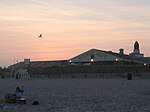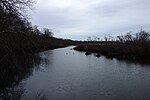Smith Point Bridge
Bascule bridges in New York (state)Bridges in Suffolk County, New YorkBridges on Long IslandBrookhaven, New YorkRoad bridges in New York (state) ... and 1 more
Steel bridges in the United States

The Smith Point Bridge is a steel bascule drawbridge in Shirley, New York that connects Long Island to Fire Island. Located on the south shore of central Suffolk County, the bridge carries William Floyd Parkway (Suffolk CR 46) across The Narrows between Bellport Bay (an arm of the Great South Bay) and Moriches Bay. It connects Long Island with Smith Point County Park and the Otis Pike Fire Island High Dune Wilderness, both are a part of the Fire Island National Seashore.
Excerpt from the Wikipedia article Smith Point Bridge (License: CC BY-SA 3.0, Authors, Images).Smith Point Bridge
Smith Point Bridge,
Geographical coordinates (GPS) Address External links Nearby Places Show on map
Geographical coordinates (GPS)
| Latitude | Longitude |
|---|---|
| N 40.738333333333 ° | E -72.868055555556 ° |
Address
Smith Point Bridge
Smith Point Bridge
11951
New York, United States
Open on Google Maps








